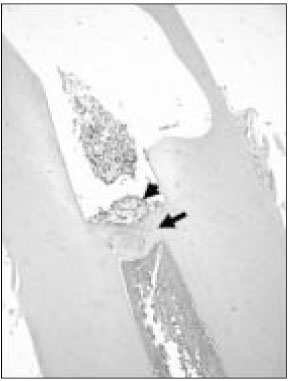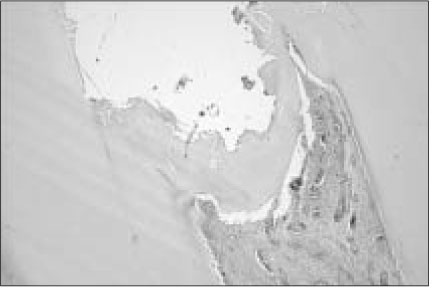Pulp response of mineral trioxide aggregate, calcium sulfate or calcium hydroxide
- Affiliations
-
- 1Department of Conservative Dentistry, DSRI, 2nd stage of BK21, School of Dentistry, Chonnam National University, Korea. wmoh@chonnam.ac.kr
- 2Department of Oral Pathology, DSRI, 2nd stage of BK21, School of Dentistry, Chonnam National University, Korea.
- 3Department of Oral and Maxillofacial Radiology, DSRI, 2nd stage of BK21, School of Dentistry, Chonnam National University, Korea.
- 4Department of Oral Anatomy, DSRI, 2nd stage of BK21, School of Dentistry, Chonnam National University, Korea.
- KMID: 2175842
- DOI: http://doi.org/10.5395/JKACD.2007.32.2.095
Abstract
- This study was performed to verify the possibility of MTA and calcium sulfate as a pulp capping agent through comparing the dental pulp response in dogs after capping with MTA, calcium sulfate, and calcium hydroxide. 24 teeth of 2 dogs, 8 month old, were used in this study. Under general anesthesia, cervical cavities were prepared and pulp was exposed with sterilized #2 round bur in a high speed handpiece. MTA, calcium hydroxide, and calcium sulfate were applied on the exposed pulp. Then the coronal openings were sealed with IRM and light-cured composite. Two months after treatment, the animals were sacrificed. The extracted teeth were fixed in 10% neutral-buffered formalin solution and were decalcified in formic acid-sodium citrate. They were prepared for histological examination in the usual manner. The sections were stained with haematoxylin and eosin. In MTA group, a hard tissue bridges formation and newly formed odontoblasts layer was observed. There was no sign of pulp inflammatory reaction in pulp tissue. In calcium hydroxide group, there was no odontoblast layer below the dentin bridge. In pulpal tissue, chronic inflammatory reaction with variable intensity and extension occurred in all samples. In calcium sulfate group, newly formed odontoblast layer was observed below the bridge. Mild chronic inflammation with a few neutrophil infiltrations was observed on pulp tissue. These results suggest that MTA is more biocompatible on pulp tissue than calcium hydroxide or calcium sulfate.
Keyword
MeSH Terms
-
Anesthesia, General
Animals
Calcium Hydroxide*
Calcium Sulfate*
Calcium*
Citric Acid
Dental Pulp
Dental Pulp Capping
Dentin
Dogs
Eosine Yellowish-(YS)
Formaldehyde
Humans
Infant
Inflammation
Neutrophils
Odontoblasts
Pulp Capping and Pulpectomy Agents
Tooth
Pemetrexed
Calcium
Calcium Hydroxide
Calcium Sulfate
Citric Acid
Eosine Yellowish-(YS)
Formaldehyde
Pulp Capping and Pulpectomy Agents
Figure
Cited by 11 articles
-
Comparison of biocompatibility of four root perforation repair materials
Min-Kyung Kang, In-Ho Bae, Jeong-Tae Koh, Yun-Chan Hwang, In-Nam Hwang, Won-Mann Oh
J Korean Acad Conserv Dent. 2009;34(3):192-198. doi: 10.5395/JKACD.2009.34.3.192.Effects of condensation techniques and canal sizes on the microleakage of orthograde MTA apical plug in simulated canals
Deuk-Lim Nam, Jeong-Kil Park, Bock Hur, Hyeon-Cheol Kim
J Korean Acad Conserv Dent. 2009;34(3):208-214. doi: 10.5395/JKACD.2009.34.3.208.A bioactivity study of Portland cement mixed with β-glycerophosphosphate on human pulp cell
Young-Hwan Oh, Young-Joo Jang, Yong-Bum Cho
J Korean Acad Conserv Dent. 2009;34(5):415-423. doi: 10.5395/JKACD.2009.34.5.415.Gene expression profiling in human dental pulp cells treated with mineral trioxide aggregate
Yong-Beom Kim, Won-Jun Shon, WooCheol Lee, Kee-Yeon Kum, Seung-Ho Baek, Kwang-Shik Bae
J Korean Acad Conserv Dent. 2010;35(3):152-163. doi: 10.5395/JKACD.2010.35.3.152.The effect of several root-end filling materials on MG63 osteoblast-like cells
Jeong-Ho Lee, Won-Jun Shon, WooCheol Lee, Seung-Ho Baek
J Korean Acad Conserv Dent. 2010;35(3):222-228. doi: 10.5395/JKACD.2010.35.3.222.Physical and chemical properties of experimental mixture of mineral trioxide aggregate and glass ionomer cement
Yu-Na Jeong, So-Young Yang, Bum-Jun Park, Yeong-Joon Park, Yun-Chan Hwang, In-Nam Hwang, Won-Mann Oh
J Korean Acad Conserv Dent. 2010;35(5):344-352. doi: 10.5395/JKACD.2010.35.5.344.Biocompatibility of experimental mixture of mineral trioxide aggregate and glass ionomer cement
Min-Jae Oh, Yu-Na Jeong, In-Ho Bae, So-Young Yang, Bum-Jun Park, Jeong-Tae Koh, Yun-Chan Hwang, In-Nam Hwang, Won-Mann Oh
J Korean Acad Conserv Dent. 2010;35(5):359-367. doi: 10.5395/JKACD.2010.35.5.359.Biocompatibility of bioaggregate cement on human pulp and periodontal ligament (PDL) derived cells
Choo-Ryung Chung, Euiseong Kim, Su-Jung Shin
J Korean Acad Conserv Dent. 2010;35(6):473-478. doi: 10.5395/JKACD.2010.35.6.473.Pulp response of beagle dog to direct pulp capping materials: Histological study
Ji-Hyun Bae, Young-Gyun Kim, Pil-Young Yoon, Byeong-Hoon Cho, Yong-Hoon Choi
J Korean Acad Conserv Dent. 2010;35(1):5-12. doi: 10.5395/JKACD.2010.35.1.005.Effects of the exposure site on histological pulpal responses after direct capping with 2 calcium-silicate based cements in a rat model
Panruethai Trongkij, Supachai Sutimuntanakul, Puangwan Lapthanasupkul, Chitpol Chaimanakarn, Rebecca Wong, Danuchit Banomyong
Restor Dent Endod. 2018;43(4):. doi: 10.5395/rde.2018.43.e36.Comparison of gene expression profiles of human dental pulp cells treated with mineral trioxide aggregate and calcium hydroxide
Yong-Beom Kim, Won-Jun Shon, Woocheol Lee, Kee-Yeon Kum, Seung-Ho Baek, Kwang-Shik Bae
J Korean Acad Conserv Dent. 2011;36(5):397-408. doi: 10.5395/JKACD.2011.36.5.397.
Reference
-
1. Schröder U. Effects of calcium-hydroxide-containing pulp capping agents on pulp cell migration, proliferation and differentiation. J Dent Res. 1985. 64 Spec No:541–548.2. Tronstad L. Reaction of the exposed pulp to Dycal treatment. Oral Surg Oral Med Oral Pathol. 1979. 38:945–953.
Article3. Schröder U, Granath LE. Early reaction of intact human teeth to calcium hydroxide following experimental pulpotomy and its significance to the development of hard tissue barrier. Odontol Revy. 1971. 22:179–188.4. Fitzgerald M. Cellular mechanisms of dentinal bridge repair using 3H-thymidine. J Dent Res. 1979. 58:2198–2206.
Article5. Fitzgerald M, Chiego JD Jr, Heys R. Autoradiographic analysis of odontoblast replacement following pulp exposure in primate teeth. Arch Oral Biol. 1990. 35:707–715.
Article6. Heys DR, Fitzerald M, Heys RJ, Chiego JD Jr. Healing of primate dental pulps capped with Teflon. Oral Surg Oral Med Oral Pathol. 1990. 69:227–237.
Article7. Holland R, de Souza V, de Mello W, et al. Permeability of the hard tissue bridge formed after pulpotomy with calcium hydroxide. A historical study. J Am Dent Assoc. 1979. 99:472–475.
Article8. Torabinejad M, Hong CU, McDonald F, Pitt Ford TR. Physical and chemical properties of a new root-end filling material. J Endod. 1995. 21:349–353.
Article9. Torabinejad M, Chivian N. Clinical applications of mineral trioxide aggregate. J Endod. 1999. 25:197–205.
Article10. Ford TR, Torbinejad M, Abedi HR, Backland LK, Kariyawasam SP. Using mineral trioxide aggregate as a pulp-capping material. J Am Dent Assoc. 1996. 127:1491–1494.
Article11. Junn DJ, McMillian P, Backland LK, Torbinejad M. Quantitative assessment of dentin bridge formation following pulp capping with mineral trioxide aggregate. J Endod. 1998. 24:278. (abstract).12. Faraco IM Jr, Holland R. Response of the observe the response of dog's dental pulp to mineral trioxide aggregate (MTA) and calcium hydroxide cement. Dent Traumatol. 2001. 17:163–166.
Article13. Bahn SL. Plaster: a bone substitute. Oral Surg Oral Med Oral Pathol. 1966. 21:672–679.
Article14. Yamazaki Y, Oida S, Akimoto Y. Response of mouse femoral muscle to an implant of a composite of bone morphogenetic protein and plaster of Paris. Clin Orthop. 1988. 234:240–249.15. Radentz WH, Collings CK. The implantation of plaster of Paris in the alveolar process of the dog. J Periodontol. 1965. 36:357–364.
Article16. Kakehashi S, Stanley HR, Fitzgerald RJ. The effects of surgical exposures of dental pulps in germ-free and conventional laboratory rats. Oral Surg Oral Med Oral Pathol. 1965. 20:340.
Article17. Mitchell PJC, Pitt Ford TR, Torabinejad M, McDonald F. Osteoblast biocompatibility of mineral trioxide aggregate. Biomaterials. 1999. 20:167–173.
Article18. Koh ET, McDonald F, Pitt Ford TR, Torabinejad M. Cellular response to mineral trioxide aggregate. J Endod. 1998. 24:543–547.
Article19. Koh ET, Torabinejad M, Pitt Ford TR, Brady K, McDonald F. Mineral trioxide aggregate stimulates a biological response in human osteoblasts. J Biomed Mater Res. 1997. 37:432–439.
Article20. Tziafas D, Pantelidou O, Alvanou A, Belibasakis G, Papadimitriou S. The dentinogenic effect of mineral trioxide aggregate (MTA) in short-term capping experiments. Int Endod J. 2002. 35:245–254.
Article21. Peltier LF. The use of plaster of Paris to fill defects in bone. Clin Orthop. 1961. 21:1–31.22. Peltier LF, Jones RH. Treatment of unicameral bone cyst by curretage and packing with plaster of Paris pellets. J Bone Joint Surg Am. 1978. 60:820–822.
Article23. Ricci JL, Rosenblum SF, Brezenoff L, Blumenthal NC. Stimulation of bone ingrowth into an implantable chamber through the use of rapidly resorbing calcium sulfate hemihydrate. 1992. Berlin: Fourth World Biomaterials Congress.24. Rauschmann MA, Wichelhaus TA, Stirnal V, Dingeldein E, Zichner L, Schnettler R, Alt V. Nanocrystalline hydroxyapatite and calcium sulphate as biodegradable composite carrier material for local delivery of antibiotics in bone infections. Biomaterials. 2005. 26:2677–2684.
Article
- Full Text Links
- Actions
-
Cited
- CITED
-
- Close
- Share
- Similar articles
-
- Chemical characteristics of mineral trioxide aggregate and its hydration reaction
- Effect of Mineral Trioxide Aggregate and Calcium Hydroxide on Reparative Dentin Formation in Rats
- Comparison of gene expression profiles of human dental pulp cells treated with mineral trioxide aggregate and calcium hydroxide
- A preliminary report on histological outcome of pulpotomy with endodontic biomaterials vs calcium hydroxide
- Use of mineral trioxide aggregate in the treatment of horizontal root fracture with a 4-year follow-up: case report





